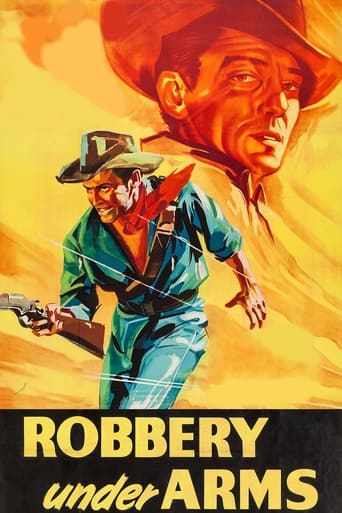Leofwine_draca
ROBBERY UNDER ARMS is an interesting little British thriller of the 1950s; it has an entirely unexpected Australian setting that stands it apart from the rest alongside the Eastmancolor vibrancy of the photography. The film stars Ronald Lewis and a youthful David McCallum (in one of his earliest roles) as a couple of outlaws working the land back in the 19th century. The film chronicles their brushes with the law and various other eccentric characters inhabiting their world, such as a world-weary Laurence Naismith and a commanding Peter Finch, and while it's never as gripping as it perhaps should be, it's certainly watchable enough.
david-sarkies
This is an early adaptation of a book of the same name. It is an English film made and set in Australia (and in fact some parts of it are set in the Flinders Ranges in South Australia, and Adelaide is one of the locations, though it hardly looks like Adelaide). The story is about two boys: Dick and Jim Madsen, whose father is a member of the bushranger Captain Starlight's gang. They start off by leading some stolen cattle to Adelaide to sell, and this one action puts their name on the wanted list, so they spend the rest of the time trying to hide from this one act.What this movie is about is how crime does not pay, even if it is a little robbery, you will blacken your name and get caught. Also, it will drag you down to a point where you get into more and more trouble. In some ways I can agree with that, but unfortunately such a moralistic movie does not work. One may continue to say, "crime doesn't pay," but unfortunately people will not listen. To a lot of people crime is the easy way out - which it is not. Just like the Madsen boys, they discovered that it was easy money, but this easy money destroyed their lives.Even so, they managed to hide, but it was a jealous girlfriend of Dick Madsen that ended up getting them caught. Moreso, after they had left the gang, their names were still tied to it, so when they were pointed out, the mob's reaction wasn't to consider whether they were involved or not, but to get them and punish them for the death of an innocent woman (whether there is any such thing as an innocent person is another story).Another thing I must note is that Dick had two girlfriends. One was a child-hood sweetheart that drifted away from him after his walk into the life of crime. The other one he met afterwards, who thought she was innocent, was a very controlling, stuck-up woman. Her statement that no man dumps her proves this. It is this woman that destroys them, for when they meet again in the goldfields she is married, but she still has an affair with him. But, when she discovers that he has another woman, she freaks and dobs him in.Another thing about this movie is that it is about bushrangers - who are Australia's legends. Even then, they are not that much of a legend, as our explorers are more legends than out bushrangers - and only Ned Kelly is the really famous one. America has more famous outlaws than does Australia (Jesse James, Billy the Kid), though people like to insist that our legends are all thieves.Another interesting thing is that it tries to show the sparseness that is Australia. Perth is half a continent away from the other major cities, and is basically isolated. I tried to conjure up where they were in Australia, but it was difficult because, with the exception of being 500 miles from Adelaide, they were vague about their other locations. One comment was by a police officer, who said he had two officers to patrol an area the size of England. What one must remember is that one millionth of the population of England lives in that area. Whatever is said, Australia is a vast and empty area, and though this film tries to create this, it basically fails.
FilmartDD
Awkward in fitting English actors into a faraway setting, and yes, over-coloured in Technicolor: so this English director caught some of the paradoxes of Australia, the raw young country less than 100 years settled in Boldrewood's yarn. Three things Jack Lee (who died only c2003) understood and expressed more fully than perhaps anyone, English or Australian. First, the wild irresponsibility of the bushranger released from society's constraints (Peter Finch's manic side caught this brilliantly). Second, the special eternal power of the ancient bush country (in this case, the Flinders Ranges, also the setting for 2002's The Tracker). Third, however briefly seen, the deep calm and perfect attunement to his country of the native man Warrigal, so that in this raw place, it is only the dispossessed who has ownership - a nod here to the real-life horseman Johnny Cadell, a screen natural.
bamptonj
Perhaps what is most distinguishing about "Robbery Under Arms" is its very noticeable utilisation of the 50's, garish Technicolor process. This was, I believe, the first time a feature length film was photographed in such a manner in Australia and based on the novel by Rolf Boldrewood. It's also good to see Peter Finch before he relocated to his native motherland. Its good to see that Australia recognised his sterling presence leagues before it was realised in Britain, and then in turn, America. Here he steals the show as Captain Starlight - representing the typical Aussie larrikin.


